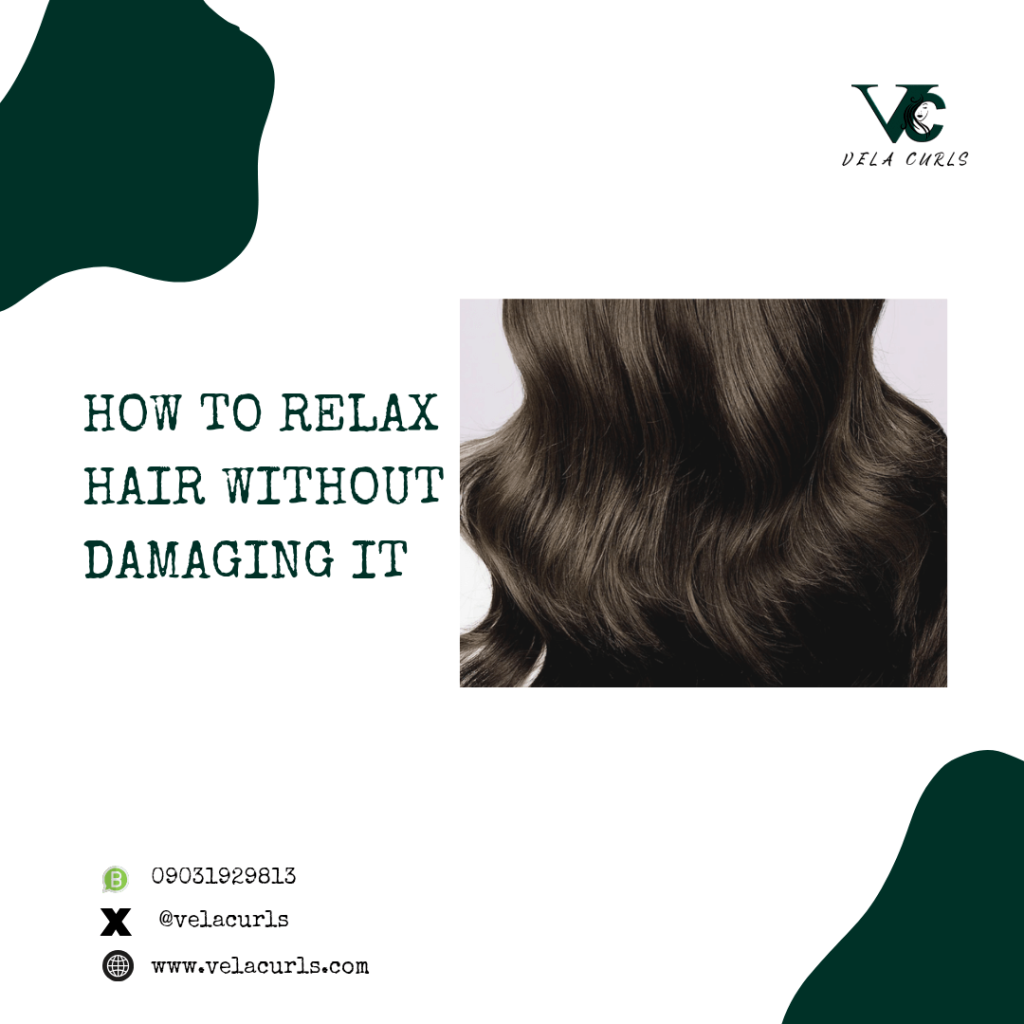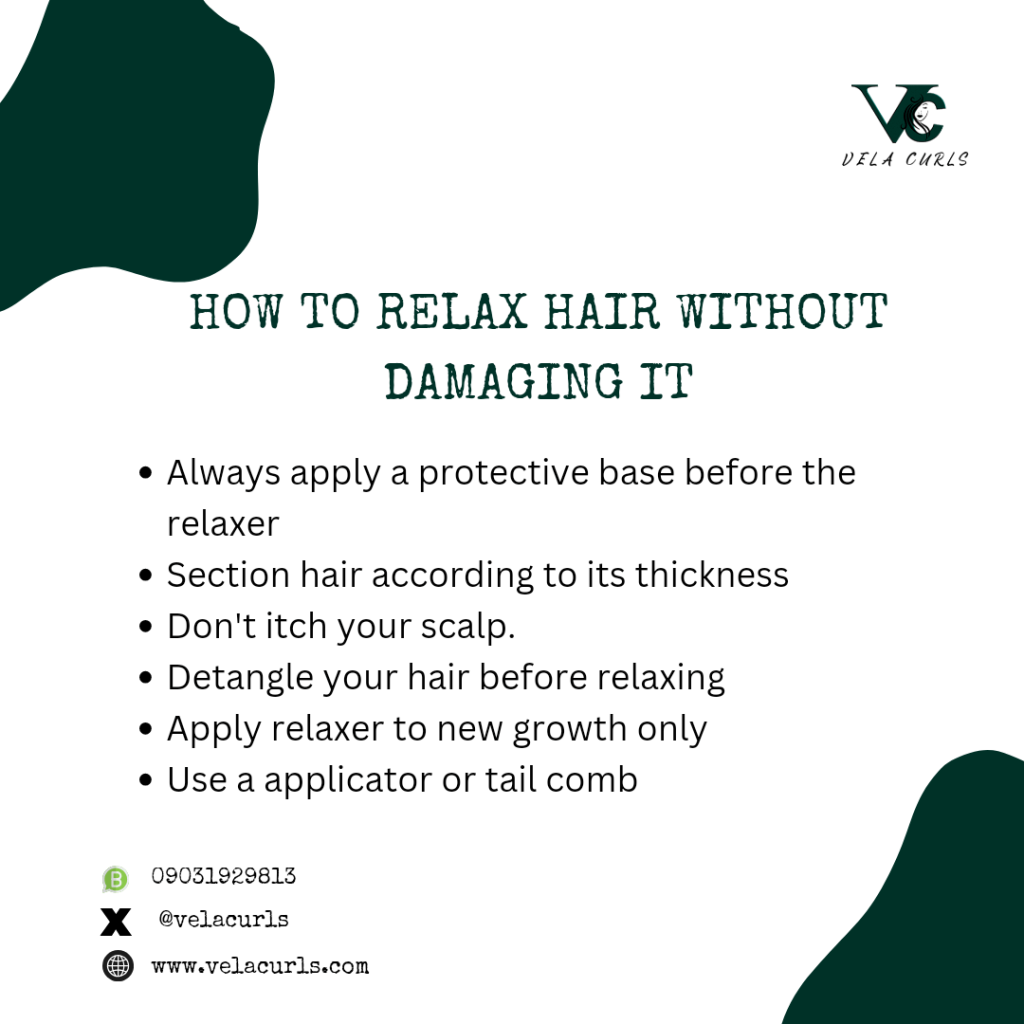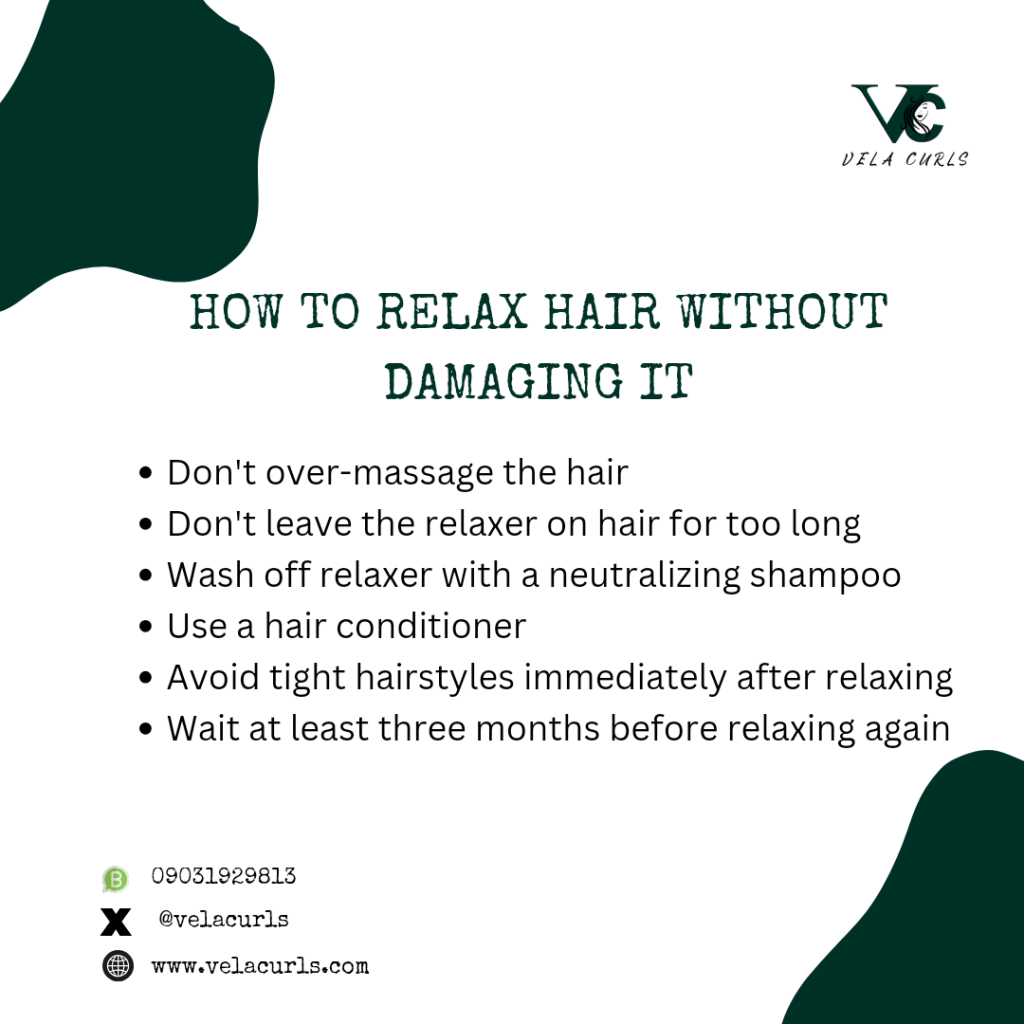Are you looking for how to relax hair without damaging it?
Great, I have twelve tips to help you do just that.
You can trust these tips because:
- I learned them from a certified hairstylist renowned for her prowess in hair relaxing.
- I had healthy, relaxed hair for over five years.
- I’ve helped people relax their hair successfully for years without damage.
Let’s get to it!
- 12 Must-Know Tips on How to Relax Hair Without Damaging it
- 1. Always Apply a Protective Base
- 2. Section the Hair According to Thickness
- 3. Don’t Itch Scalp Before Relaxing
- 4. Detangle Before Relaxing
- 5. Apply the Relaxer to New Hair Growth ONLY
- 6. Use a Tail Comb
- 7. Don’t Over-massage
- 8. Don’t Leave Relaxer on Hair for Too Long
- 9. Always Wash Off Relaxer With a Neutralizing Shampoo
- 10. Use a Hair Conditioner
- 11. Avoid Tight Hairstyles Right After Retouching
- 12. Don’t Relax Your Hair Too Often
- Extra Tips for Healthy Relaxed Hair
- Relax Strands With No Damage

12 Must-Know Tips on How to Relax Hair Without Damaging it
Here are twelve things to do (and not do) when relaxing your hair to keep it damage-free.

1. Always Apply a Protective Base
In other words, always base the scalp before applying a relaxer. How?
Apply hair cream or oil to your hair edges (front, sides, especially behind the ears, and back). You should also apply the cream or oil to the sectioning lines.
The goal is to protect these sensitive parts of your scalp so the relaxer doesn’t “burn” them.
Vela Tip: If the scalp is super sweaty, sprinkle some white powder on it before applying a relaxer.
It’s a tip I learned in the salon I worked at, and it prevents the relaxer from burning sensitive scalp.
2. Section the Hair According to Thickness
People usually section hair into three when they want to apply a relaxer — one back section and two front sections.
But this isn’t a die-hard rule.
Depending on the hair’s thickness, you can section it into four or even five.
The goal is to have a reasonable and workable amount of hair in each section.
Also, you should “change style” depending on the distribution of hair thickness.
My mum and aunt, for example, have thicker hair at the back.
So I usually section their hair into four so I can have two smaller back sections.
And I always start applying the relaxer from the back. Just, do what works for the hair!
3. Don’t Itch Scalp Before Relaxing
The goal is no damage, right?
Well, if you itch your scalp, it becomes sensitive. And when you apply a relaxer, you’ll get that burning sensation, and the relaxing process becomes not-so-enjoyable.
But that’s not all.
Itching your scalp before relaxing makes it likely to burn, and you may end up with “wounds” on your scalp.
Prevent all that stress by keeping your hands away from your scalp.
Vela Tip: It’s not a good idea to wash your hair before relaxing it. Leave the product and dirt buildup; they’ll all go away when you shampoo your hair after relaxing.
4. Detangle Before Relaxing
Never apply a relaxer when your hair is all tangled and knotted.
It’s the easiest way to lose a lot of hair strands.
Make sure you thoroughly detangle your hair before scooping a relaxer on it.
In summary, what to do before relaxing hair?
- Detangle your hair
- Don’t itch it
- Section hair according to thickness
- Apply a protective base
5. Apply the Relaxer to New Hair Growth ONLY
Your older hair strands do not need a relaxer; they’re relaxed already.
If you apply a relaxer on them again, you’ll damage them over time.
So, apply the hair relaxer to new growth (or undergrowth) only.
You’ll find it easier to touch only new growth when you use the back of a tail comb.
Speaking of which…
6. Use a Tail Comb
A tail comb is a simple but very effective tool for relaxing hair without damaging it.
Use the tail end to part the hair into small sections and the smooth back to apply relaxer to each hair section.
The smooth back also works well for massaging the relaxer into the hair.
Even better, there are applicator combs designed for hair relaxing.
Using one makes the whole relaxing process hassle-free.

7. Don’t Over-massage
It’s okay to massage the relaxer into the hair after an all-round application, but don’t overdo it.
If you fondle and drag the hair too much, it’ll hurt the scalp and can leave it burnt.
Plus, it doesn’t even guarantee that the hair will relax better.
So, don’t “jack” the hair when relaxing.
Vela Tip: Brushing the hair with the teeth of a tail comb is an effective way to get the relaxer in without hurting your scalp.
However, make sure you’re brushing, not combing the hair. Wait until the hair is well relaxed before combing it.
8. Don’t Leave Relaxer on Hair for Too Long
Most relaxers have application instructions on the kit or sachet, including how long the relaxer should stay on the hair.
Follow it strictly.
I know, sometimes it feels like the hair isn’t “done” yet after the specified time.
But leaving the relaxer on for too long doesn’t make it more relaxed; it only damages your hair gradually.
If you apply the relaxer properly, the hair will relax within the specified time.
So what to do when relaxing hair?
- Apply to new growth only
- Use a tail comb
- Don’t over-massage the hair
- Wash off the relaxer within the specified time
9. Always Wash Off Relaxer With a Neutralizing Shampoo
This is not even negotiable.
Never use the usual shampoo to wash your hair after relaxing.
Neutralizing shampoos are designed to counteract the “relaxing” effects of hair relaxers and balance the hair’s pH.
Aside from that, they usually have a color indicator that tells you if there’s any relaxer left in the hair.
Usually, the lather will turn pink if the hair still has relaxer and turn white when the relaxer is off.
With the usual shampoo, you can only guess whether or not you’ve washed the relaxer off completely.
Leftover relaxers in hair can be terrible, so neutralizing shampoos are safer.
10. Use a Hair Conditioner
Relaxers make the hair straight and easier to manage, but they break down your hair’s natural structure to achieve that.
In other words, they remove the hair’s strength (and some moisture too).
To avoid eventual hair damage, you should replace the lost strength and moisture by using hair conditioners.
Deep condition your hair after each relaxing process and apply hair oils to seal the moisture.
11. Avoid Tight Hairstyles Right After Retouching
One thing we’d never do in the hair salon where I worked is make a tight hairstyle (especially with extensions!) for a client immediately after relaxing her hair.
Newly relaxed hair strands are like newborn babies: fresh and pretty but weak.
You should wait at least four days after retouching before making hairstyles like Ghana weaving or braids with extensions.
Style your hair in a simple messy bun or other low-pressure styles in the meantime.
12. Don’t Relax Your Hair Too Often
How often is too often? Anything more than every three months.
You may choose to wait up to four months before retouching your hair; that’s fine.
Just don’t go below the three-month benchmark because you’ll be heading towards chemical hair damage.
So what to do after applying a hair relaxer?
- Wash the hair with a neutralizing shampoo
- Condition your hair
- Avoid tight hairstyle
- Wait at least three months before relaxing the hair again
Extra Tips for Healthy Relaxed Hair
The 12 tips above will guide your relaxing/retouching process so it goes smoothly.
But keeping healthy, relaxed hair goes beyond what happens during the relaxing process.
Here are other tips to keep your relaxed hair healthy and retain as much length as possible!
- Use but don’t overuse protein treatments
- Cut back on other chemical products like dyes and bleaches
- Cut back on heat styling
- Sleep with a satin scarf or bonnet
- Trim off split ends when they appear
- Use hair oils
- Keep your hair moisturized with hair conditioners
- Deep condition your hair regularly (say, twice a month)
- Handle your hair gently to avoid breakage
- Do protective hairstyles
- Use a wide-toothed comb for your hair
Relax Strands With No Damage
When some people hear “relaxed hair,” they think “damaged hair.”
Well, not when you do it right. Relaxed hair can be beautiful AND HEALTHY.
Follow the 12 types on how to relax hair without damaging it, and you’ll be good to go.
Don’t forget the extra tips for healthy relaxed hair too!